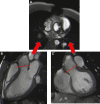Is there a role for cardiovascular magnetic resonance imaging in the assessment of biological aortic valves?
- PMID: 38124892
- PMCID: PMC10730731
- DOI: 10.3389/fcvm.2023.1250576
Is there a role for cardiovascular magnetic resonance imaging in the assessment of biological aortic valves?
Abstract
Patients with biological aortic valves (following either surgical aortic valve replacement [SAVR] or trans catheter aortic valve implantation [TAVI]) require lifelong follow-up with an imaging modality to assess prosthetic valve function and dysfunction. Echocardiography is currently the first-line imaging modality to assess biological aortic valves. In this review, we discuss the potential role of cardiac magnetic resonance imaging (CMR) as an additional imaging modality in situations of inconclusive or equivocal echocardiography. Planimetry of the prosthetic orifice can theoretically be measured, as well as the effective orifice area, with potential limitations, such as CMR valve-related artefacts and calcifications in degenerated prostheses. The true benefit of CMR is its ability to accurately quantify aortic regurgitation (paravalvular and intra-valvular) with a direct and reproducible method independent of regurgitant jet morphology to accurately assess reverse remodelling and non-invasively detect focal and interstitial diffuse myocardial fibrosis. Following SAVR or TAVI for aortic stenosis, interstitial diffuse fibrosis can regress, accompanied by structural and functional improvement that CMR can accurately assess.
Keywords: cardiovascular magnetic resonance; extracellular volume; myocardial fibrosis; paravalvular aortic regurgitation; surgical bioprosthetic aortic valve replacement; trans aortic valve implantation.
© 2023 Vermes, Iacuzio, Maréchaux, Levy, Loardi and Tribouilloy.
Conflict of interest statement
The authors declare that the research was conducted in the absence of any commercial or financial relationships that could be construed as a potential conflict of interest.
Figures






References
Publication types
LinkOut - more resources
Full Text Sources

